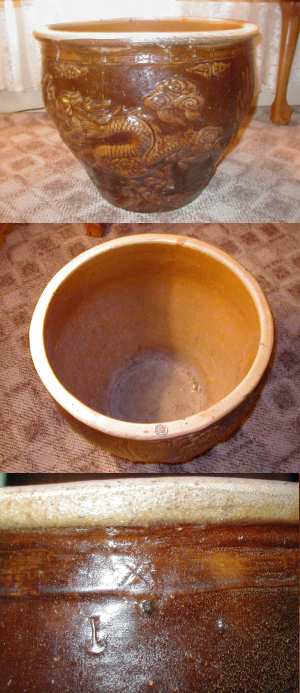
This page is only one of many thousands of Gotheborg.com Help and Information Pages, offering specialized knowledge on Chinese and Japanese Porcelain, including a Glossary, Q&A, Chinese and Japanese Porcelain Marks, Chinese Porcelain Exhibition and Excavation reports etc. For personal help and far more information, join our Discussion Board or use 'Ask a Question' for quick email consultations. For full text and better navigation, use a full-screen device rather than a mobile phone, that offers only limited content.

I recently bought a very large piece of pottery at a yard sale. I have done some research on it, but still don't know really what I have.
Any help would be appreciated. The jar is all brown with two dragons on it. The woman I bought it from said that it was used to store rice and that she purchased it in China herself several years ago, but she is moving and it costs a lot to ship. I would guess it weighs around 50 lbs.
The only mark I can find on it is a "X" with a square around it. The dragons look as if they are above water; the inside is more of a mute yellow, golden color and has very heavy brush marks.
Could you tell me about how old it is and its worth.
Thank you for the pictures of your quite decorative jar.
Big jars have been made all over Asia to store fresh water in; to store live fishes in and to all other kinds of storage purposes since they learnt how to throw clay and, they are still making large jars. Maybe more so today than ever.
When China started to modernize its pottery industry under the Department of Light Industry in the early 1950s all kind of wares that would fit to be sold and exported was revived and the production modernized. Among these where also huge glazed jars like this one.
Stylistically, this jar could very well belong to the late Qing dynasty, and does have a lot in common with roof tiles produced since Ming times up until today. The decoration I would say is "above average", with the traditional Chinese dragon above waves. Unfortunately, there is no way for me today even to guess exactly where this one have been made, nor if it is from northern or southern China, or in fact if it is made in China at all. Several South East Asian countries are making similar pots. The "X" mark, though, I feel are indicating a post 1950s date.
The collectors's value is normally "limited" since they are expensive to ship and do not fit into ordinary western people's bookshelves. It is very decorative though, and might find a new career as a flowerpot.
To find more about big Asian jars, please search my site for "Martaban".
Jan-Erik Nilsson
Less than one day after this page had gone on-line, the signature "IP" sent me the following interesting information:
Hi, Jan-Erik. I was just reading some of your new posts in the Q & A section of your page and just wanted to make an addition to this specific post about this large jar.
We have over 40 of them in our house, who are being used as flowerpots. They are originally called "Pi Tang Kong" and I would say the majority are from China, though a few may be from Taiwan. As you know "Pi Tang" are Chinese preserved eggs. These eggs are rolled in a combination of rice husks and clay and then, preserved. (How, I have no idea.) "Kong" means container thus the name literally translates into "Container of Preserved Eggs".
They are modern pieces, made to ship a large number of these eggs. In the local Chinese grocery stores in Malaysia, these jars and their contents are put in front of the shops on the sidewalk to sell the eggs. The jar usually having a round wooden cover.
Once the eggs are sold, the jar is usually sold to avid gardeners who punch a hole through the bottom with a drill to convert them to flower pots. I know, cause I have punched many of these holes myself. Use only drills cause if you use a hammer and a chisel the whole bottom of these jars will give way leaving a hole, way too large for a flowerpot!
I have seen four types of these jars. The first has the same glaze as the one shown here, but has pattern of the dragons simply incised in the clay before firing.
The second type is of a lighter color (more like sand) with the dragon pattern applied as a thin layer of clay (like sticking a thin piece of clay to the sides and carving away excess clay until a pattern of a dragon emerges). This type tends to be composed of a rougher type of clay with more grit. They are usually lighter, more porous and have thinner walls.
The third type is similar to the second type above, but tends to be larger, has greenish or pale olive glaze. The rim and dragon patterns are usually glazed brown. These types are by far the heaviest and have thick walls. The usual sizes of these types are about 20-25 inches high and about 25 inches in diameter but I have seen larger.
The fourth type is the one seen here. These seems to be the most common. In addition, they come in two distinct sizes. The smaller is about 10 inches high and about the same in diameter. The larger is about 15 inches high and about the same in diameter.
These jars are very useful for a wide range of things. Personally, I have seen them as containers for rice, water, dry foodstuff, manure, fertilizer and a whole lot more.